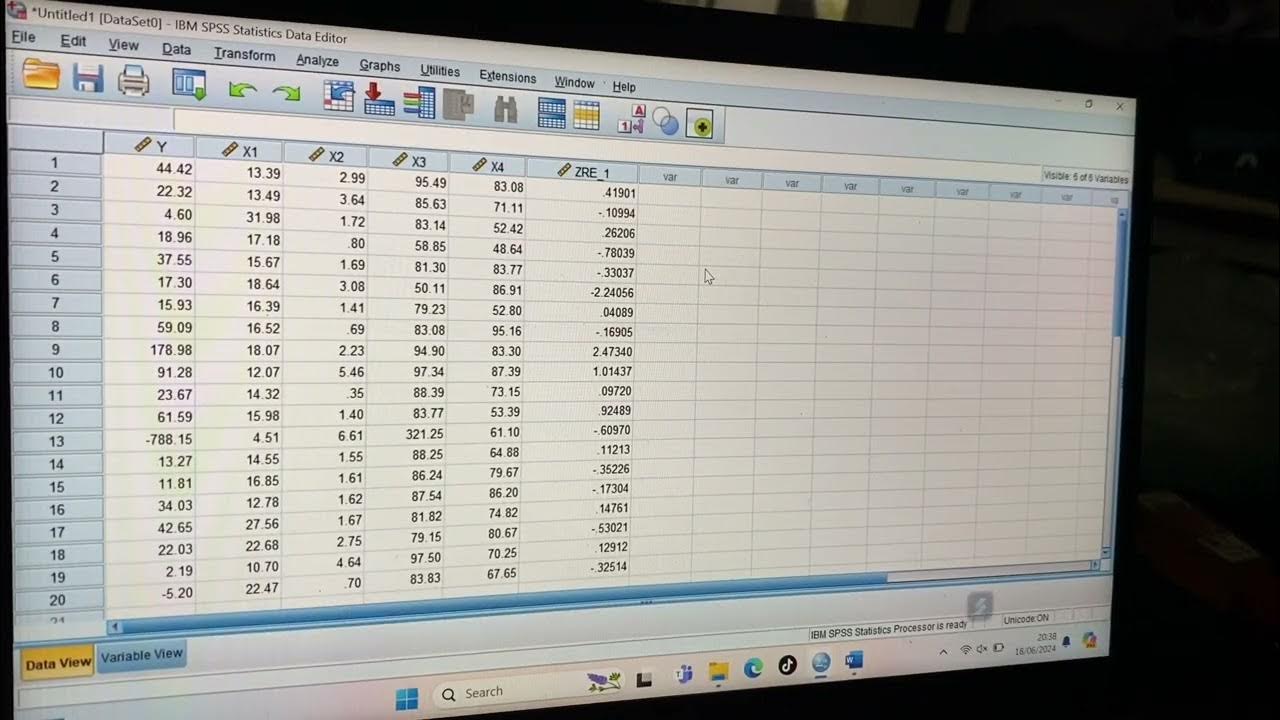Uji Asumsi Klasik SPSS Data Kuesioner beserta Analisis Regresi Linear Berganda
Summary
TLDRIn this video, the presenter provides a comprehensive tutorial on multiple linear regression analysis using SPSS, alongside classical assumption tests for questionnaire data. The video covers key concepts such as the impact of independent variables like service quality, promotion, and price on purchasing decisions. It explores statistical tests for multicollinearity, normality, and heteroscedasticity using tools like tolerance, VIF, PP plots, and the Kolmogorov-Smirnov test. The presenter guides viewers through performing regression analysis, hypothesis testing, and interpreting outputs to draw conclusions about the data, ensuring clarity and practical understanding throughout.
Takeaways
- 😀 Multiple linear regression aims to assess the influence of multiple independent variables on a dependent variable.
- 😀 A valid regression model must pass classical assumption tests, which include tests for multicollinearity, normality, and heteroscedasticity.
- 😀 Multicollinearity can be tested using tolerance and VIF methods, with acceptable values being a tolerance greater than 0.100 and VIF less than 10.
- 😀 Normality can be tested using the PP Plot (Probability Plot) and the Kolmogorov-Smirnov test.
- 😀 Heteroscedasticity can be tested using scatterplots and the Glejser test.
- 😀 In a case study, the influence of service quality, promotion, and price on purchasing decisions was analyzed, with all three being independent variables.
- 😀 SPSS version 23 is used for performing the analysis, with data inputted using a Likert scale transformed into intervals using the MSI method.
- 😀 The classical assumption tests confirmed the data did not show multicollinearity, was normally distributed, and did not exhibit heteroscedasticity symptoms.
- 😀 The regression equation for the case study showed the relationship between the independent variables and purchasing decisions, with specific regression coefficients for each variable.
- 😀 The F-test in multiple linear regression showed a significant joint effect of the independent variables on purchasing decisions.
- 😀 The T-test analysis for each independent variable (service quality, promotion, price) showed all had significant effects on the dependent variable, confirming the hypotheses.
Q & A
What is the primary purpose of multiple linear regression analysis?
-The primary purpose of multiple linear regression analysis is to determine the relationship between two or more independent variables and a dependent variable, and to assess whether these independent variables have a significant effect on the dependent variable.
How many independent variables are required in multiple linear regression analysis?
-In multiple linear regression analysis, at least two independent variables are required.
What are classical assumption tests, and why are they important?
-Classical assumption tests are used to validate the underlying assumptions of regression analysis, ensuring that the model's results are reliable. These tests include multicollinearity, normality, and heteroscedasticity tests. They are important because violations of these assumptions can lead to inaccurate or biased results.
What are the three key statistical tests used in classical assumption testing for questionnaire data?
-The three key statistical tests are: 1) Multicollinearity test, 2) Normality test, and 3) Heteroscedasticity test.
What is the purpose of the multicollinearity test in multiple linear regression?
-The multicollinearity test is used to check if the independent variables in the regression model are highly correlated with each other. If they are, it can lead to unreliable coefficient estimates.
How is multicollinearity assessed in SPSS?
-In SPSS, multicollinearity is assessed using the Tolerance and Variance Inflation Factor (VIF) methods. A tolerance value greater than 0.100 and a VIF value less than 10 indicate that there is no multicollinearity problem.
What are the two methods used to test for normality in SPSS?
-The two methods used to test for normality in SPSS are the Probability Plot (PP Plot) and the Kolmogorov-Smirnov test.
How is heteroscedasticity tested in SPSS?
-Heteroscedasticity is tested in SPSS using two methods: the scatterplot test and the Glejser test. The scatterplot looks for a non-random pattern in the residuals, and the Glejser test regresses the independent variables on the absolute residuals.
What does it mean if a regression model passes the classical assumption tests?
-If a regression model passes the classical assumption tests, it means that the model is valid for analysis. Specifically, the assumptions of no multicollinearity, normally distributed errors, and no heteroscedasticity have been met, ensuring reliable and accurate results.
How is the significance of independent variables determined in multiple linear regression?
-The significance of independent variables is determined through the t-test. If the p-value (significance) is less than 0.05, it indicates that the independent variable has a significant effect on the dependent variable.
What is the coefficient of determination (R²), and how is it interpreted?
-The coefficient of determination (R²) measures the proportion of variance in the dependent variable that is explained by the independent variables. An R² value of 0.622, for example, means that 62.2% of the variation in the dependent variable is explained by the independent variables, with the remaining 37.8% influenced by other factors.
Outlines

This section is available to paid users only. Please upgrade to access this part.
Upgrade NowMindmap

This section is available to paid users only. Please upgrade to access this part.
Upgrade NowKeywords

This section is available to paid users only. Please upgrade to access this part.
Upgrade NowHighlights

This section is available to paid users only. Please upgrade to access this part.
Upgrade NowTranscripts

This section is available to paid users only. Please upgrade to access this part.
Upgrade NowBrowse More Related Video

Tutorial Uji Asumsi Klasik dengan SPSS serta Interpretasi Output

TUTORIAL UJI ASUMSI KLASIK VARIABEL MODERASI DENGAN SPSS -TERBARU ❗❗❗

Statistika: Uji Korelasi-Regresi sederhana menggunakan SPSS

Tutorial Uji Asumsi Klasik (Prasyarat) Beserta Uji Regresi Berganda Dengan SPSS

Uji t dan Uji F dalam Analisis Regresi Berganda dengan SPSS Lengkap

Tutorial Menggunakan Spss untuk data Panel
5.0 / 5 (0 votes)